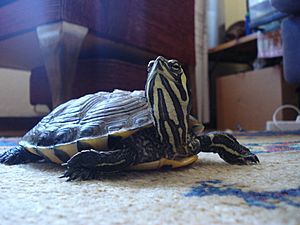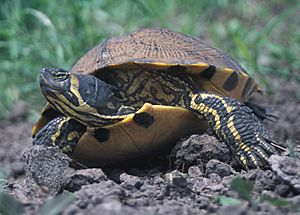Yellow-bellied slider facts for kids
Quick facts for kids Trachemys scripta scripta |
|
|---|---|
 |
|
| Female yellow-bellied slider | |
| Conservation status | |
| Scientific classification |
|
| Kingdom: | Animalia |
| Phylum: | Chordata |
| Class: | Reptilia |
| Order: | Testudines |
| Suborder: | Cryptodira |
| Family: | Emydidae |
| Genus: | Trachemys |
| Species: | |
| Subspecies: |
T. s. scripta
|
| Trinomial name | |
| Trachemys scripta scripta (Thunberg in Schoepff, 1792)
|
|
| Synonyms | |
|
|
The yellow-bellied slider (Trachemys scripta scripta) is a type of turtle that lives both on land and in water. It belongs to the Emydidae family. This turtle is native to the southeastern United States. You can find it from Florida up to southeastern Virginia. It is the most common turtle in these areas.
Yellow-bellied sliders live in many different watery places. These include slow-moving rivers, floodplain swamps, and marshes. They also live in seasonal wetlands and permanent ponds. These turtles are also very popular as pets.
Contents
Yellow-Bellied Slider: Appearance and Features
Adult male yellow-bellied sliders usually grow to be about 5 to 9 inches (13 to 23 cm) long. Females are larger, ranging from 8 to 13 inches (20 to 33 cm). The top shell, called the carapace, is usually brown and black. It often has yellow stripes.
The turtle's skin is olive green. It has bright yellow patches on its neck and legs. As its name suggests, the bottom shell, called the plastron, is mostly yellow. It has black spots along the edges. Older turtles tend to get darker in color.
Yellow-bellied sliders can sometimes be confused with eastern river cooters. River cooters also have yellow stripes on their necks and yellow undersides. However, they do not have the green spots that yellow-bellied sliders do. The yellow-bellied slider often has an "s"-shaped yellow stripe on its face. They also have markings on their bellies that look like question marks.
Life Cycle and Habits
Yellow-bellied sliders are active during the day. They mainly eat in the morning. During the rest of the day, they often bask in the sun. They do this on shore, on logs, or while floating in the water. At night, they sleep on the bottom of the water or near brush piles on the surface.
These turtles are found most often where there is a lot of algae and water plants. These plants, like Myriophyllum spicatum and lily pads, form thick mats on the water's surface. This dense plant cover helps protect them from predators. It also provides a good place to find food, like small water bugs and tiny fish.
In the wild, yellow-bellied sliders can live for over 30 years. In captivity, they can live for more than 40 years.
Reproduction and Diet
Mating can happen in spring, summer, and autumn. Yellow-bellied sliders can interbreed with other types of T. scripta turtles. This includes red-eared sliders, which are often sold as pets. Because non-native red-eared sliders were released into Florida's environment, the state banned their sale. This was done to protect the native yellow-bellied slider population.
Mating takes place in the water. Female turtles need dry land to lay their eggs. They usually lay 6 to 10 eggs at a time. Larger females can lay more eggs. The eggs hatch after 2 to 3 months. The baby turtles usually stay in the nest through the winter.
Baby yellow-bellied sliders are almost entirely carnivorous. They eat insects, spiders, crustaceans, tadpoles, fish, and dead animals. As they grow older, adult turtles eat less meat. Eventually, up to 95% of their food comes from plants.
Caring for Yellow-Bellied Sliders as Pets
Housing Your Turtle
Young yellow-bellied sliders can live in a smaller tank, about 20 to 40 gallons. But as they get older, after about three years, they need much more space. An adult turtle needs an aquarium of 75 US gallons (284 liters) or larger. The water should be deep enough for the turtle to turn around, about 16 to 18 inches (41 to 46 cm) is recommended.
The water temperature should be kept between 72–80 °F (22–27 °C). It also needs to be properly filtered. It's usually best not to keep fish with turtles, as the turtle might eat them.
Sliders need a dry area where they can bask. This area should be warm during the day. It allows the turtle to move around, balance, and dry off completely. This basking spot should be about 89–95 °F (32–35 °C). You can heat it with a UV-A heat lamp. A second lamp that produces UV-B light is very important. This light helps the turtle use calcium properly for strong bones and shell. Direct, unfiltered sunlight is even better if possible. Both lamps should be on during daylight hours.
What to Feed Your Turtle
You can put pond plants like elodea (anacharisan) and cabomba in the water for your turtle to eat. You can also give them human-friendly vegetables. These include romaine lettuce, escarole, and collard greens. These fresh vegetables must be changed daily.
Sliders are omnivores, meaning they eat both plants and meat. You can also give them insects and freshly killed fish for protein. Commercial reptile food made for turtles can also be given. Any leftover food should be removed quickly. This stops the water or the turtle's home from getting dirty.
Gallery
-
Trachemys scripta scripta in Francis Beidler Forest
See also
 In Spanish: Tortuga de orejas amarillas para niños
In Spanish: Tortuga de orejas amarillas para niños









